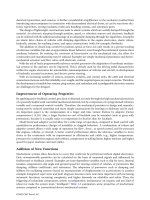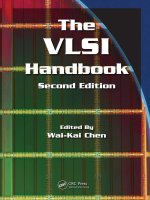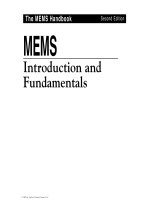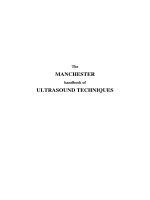The peeragogy handbook
Bạn đang xem bản rút gọn của tài liệu. Xem và tải ngay bản đầy đủ của tài liệu tại đây (3.8 MB, 234 trang )
e Peeragogy Handbook
with contributions from
Bryan Alexander, Paul Allison, Régis Barondeau,
Doug Breitbart, Suz Burroughs, Joseph Corneli,
Jay Cross, Charles Jeffrey Danoff, Julian Elve,
María Fernanda, James Folkestad, Kathy Gill,
Gigi Johnson, Anna Keune, Roland Legrand,
Amanda Lyons, Christopher Neal, Ted Newcomb,
Stephanie Parker, Charloe Pierce, David Preston,
Howard Rheingold, Paola Ricaurte, Stephanie Schipper,
Fabrizio Terzi, and Geoff Walker
Tuesday 1st January, 2013 (version 1.0)
All content here is Public Domain unless noted.
Text in corresponds to links in the
online version of the book, which is at
.
CONTENTS
I
I
1
1
W!
3
2
H
5
II P L
7
3
9
O
III C A G
29
4
C
31
5
K12 P
39
6
R P
47
IV O L C
51
7
O CL
53
8
A
63
9
T
69
10 H O MOOC
77
11 P
85
12 T W
89
V CF CW
93
ii
13 C
CONTENTS
95
14 D
101
15 P
107
VI A
113
16 P A
115
17 F
123
VII P, U C, E
125
18 T
127
19 P H
131
20 P
133
21 A
141
22 U C
149
VIII T, S, P
171
23 P T
173
24 W
187
25 R M
195
IX R
201
26 H
203
27 P A
211
28 S G
219
29 M A
223
Part I
Introduction
1
WELCOME TO THE PEERAGOGY HANDBOOK, A
RESOURCE FOR SELF-ORGANIZING
SELF-LEARNERS∗
Welcome to the Peeragogy Handbook!
is book, and accompanying website, is a resource for selforganizing self-learners.
With YouTube, Wikipedia, search engines, free chatrooms,
blogs, wikis, and video communication, today’s
have power never dreamed-of before. What does any group
of self-learners need to know in order to self-organize learning about any topic? e Peeragogy Handbook is a volunteercreated and maintained resource for bootstrapping peer learning.
is project seeks to empower the worldwide population of
self-motivated learners who use digital media to connect with
each other, to co-construct knowledge of how to co-learn. Colearning is ancient; the capacity for learning by imitation and
more, to teach others what we know, is the essence of human culture. We are human because we learn together. Today,
however, the advent of digital production media and distribution/communication networks has raised the power and potential of co-learning to a new level.
If you want to learn how to fix a pipe, solve a partial differential equation, write soware, you are seconds away from
know-how via YouTube, Wikipedia and search engines. Access
to technology and access to knowledge, however, isn’t enough.
Learning is a social, active, and ongoing process.
What does a motivated group of self-learners need to
know to agree on a subje or skill, find and qualify the best learning resources about that topic, sele
and use appropriate communication media to co-learn
3
4
CHAPTER 1. WELCOME!
it? In particular, what do they need to know about
peer learning?
is handbook is intended to answer these questions, and in
the process, build a toolbox for co-learning.
Our experience within this project has been that flaened
hierarchies do not necessarily mean decisions go by consensus. e handbook is in part a collaboration? and in part a
collection of single-author works. Oen the lines and voices
are blurred. One constant throughout the book is our interest
in making something useful. To this end, the book comes with
numerous activities, and is available under non-restrictive legal
terms (you can reuse portions of it however you see fit it has
been given a CC Z 1.0 U P D D
). For those who seek more evidence-based, scholarly scaffolding for learning practices, we also maintain a
of learning theories that pertain to self-organized peer
learning.
Finally, we also include instructions on
.
Sincerely, T P T
2
HOW TO USE THIS HANDBOOK
Author: Howard Rheingold
is document is a practical guide to online co-learning, a
living document that invites comment and invites readers to join
the community of editors; the document does not have to be read
in linear order from beginning to end.
If you and a group of other people want to use digital media
and networks to co-learn together, this handbook is a practical tool for learning how to self-organize peer learning – what
we call “peeragogy.” Material about conceptualizing and convening co-learning – the stuff about geing started – is located
toward the top of the table of contents. Material about assessment, resources, use cases is located toward the boom of the
TOC. But you don’t have to read it in sequential order. Hop
around if you’d like. We think – and some research seems to
support – that understanding how co-learning works will help
you do co-learning more effectively. So we’ve included material
about learning theories that support peer learning or that reveal
useful characteristics of successful peer learning. For those who
want to delve more deeply into the empirical research and scholarship, we’ve linked to a sister document – a literature review
of learning theory related to peeragogy. For those who want to
study more deeply about the aspects of peer learning we summarize in our articles, we provide a list of links to related handbook articles, and a set of resources for further study. ink of
our pages as both places to start and as jumping off points.
e short videos, most of them under one minute long, at the
very beginning of many articles are meant to convey a sense of
what the article and its supporting material is meant to convey.
is is a living document. If you want to join our community
of editors, contact (If you want to see
how we go about creating a handbook entry, see our guide for
newcomers.) If you don’t want to go as far as joining the com5
6
CHAPTER 2. HOW TO USE THIS HANDBOOK
munity of editors, please feel free to use the comment thread
aached to each page to suggest changes and/or additions.
See also
• G
• T T C
• O
• O
Part II
Peer Learning
3
OVERVIEW
is part of the book offers our most important insights into
peer learning. A number of earlier theories and experiments
have focused on various aspects of collaborative, connective,
and shared, non-didactic learning systems. ere’s a rumbling
among several well-known thinkers that when combined with
new technologies, peer learning strategies could have a big impact on the way educational institutions work in the future. Our
aim here is just to make the basic ideas concretely understandable and immediately applicable. e best course is to try it out
and see how it works for you.
Peeragogy is about peers learning together and helping each
other learn. e idea is that each person contributes to the group
in their own way. e contribution of each peeragogue depends
on a healthy sense of self-awareness. You ask yourself, “What
do I have to offer?” and “What do I get out of it?” We think
you’ll come up with some exciting answers to those questions!
Our first strategy for peer learning invites you to engage in a
self-assessment of your motivations. Here you take into account
things like the learning context, timing and sequence of learning
activities, social reinforcements, and visible reward. Our view
is that learning is most effective when it contains some form of
9
10
CHAPTER 3. OVERVIEW
enjoyment or satisfaction, or when it leads to a concrete accomplishment.
Indeed, this is the kind of learning that you choose to do,
whether you’re being “trained” or not. You’re in charge! Furthermore, this kind of learning is usually fun. Indeed, as we’ll
describe below, there are deep links between play and learning. We believe we can improve the co-learning experience by
adopting a playful mindset. Certainly some of our best learning moments in the Peeragogy project have been peppered with
humor and banter.
Apart from self-assessment and playfulness, here are two
key factors to keep in mind:
“Personal” supports “peer”: We can consciously cultivate
living, growing, responsive webs of information, support, and
inspiration that help us be more effective learners. is is a “personal learning network”. We’ll offer tips on how to build these
networks – and we’ll also explain how strong personal learning
networks can evolve into even stronger peer learning networks.
“Peer” supports “personal”: As we work together to develop shared plans or “roadmaps” for our collective efforts in
group projects, we usually can find places where we have something to offer, and places where we have something to learn.
Furthermore, if we are willing to ask for some help and offer our
help to others, then we can really learn a lot! is is why building effective interpersonal learning strategies should be part of
your personal learning plan.
In the following sections, you can read some more about
these strategies, or you can skip ahead to P III to start looking at techniques you can use to build your own peer learning
group.
Peer learning through the ages
e new term, “peeragogy,” that we use in this book is a riff
on the word pedagogy — the art, science, or profession of teaching. Pedagogy has a somewhat problematic story of origin: it
comes from the ancient Greek tradition of having a child (paidos) be supervised (agogos) by a slave. Greek philosophers dis-
11
agreed with each other as to the best way for individuals to gain
knowledge (and even more so, wisdom). Socrates, who insisted
that he was not wise, also insisted that his interlocutors join
him in investigating truth claims, as peers. e most famous
of these interlocutors, Plato, on a more pedagogical bent, spoke
of an enlightened few, whose responsibility it was to show others the light of knowledge (illustrated by his famous allegory of
“e Cave”).
In more recent centuries, various education theorists and reformers have challenged the effectiveness of what had become
the traditional teacher-led model. Most famous of the early education reformers in the United States was John Dewey, who advocated new experiential learning techniques. In his 1916 book,
Democracy and Education[1], Dewey wrote, “Education is not
an affair of ‘telling’ and being told, but an active and constructive process.” Soviet psychologist Lev Vygotsky, who developed
the concept of the Zone of Proximal Development, was another
proponent of “constructivist” learning. His book, ought and
Language, also gives evidence to support collaborative, socially
meaningful, problem-solving activities over solo exercises [2].
Within the last few decades, things have begun to change
very rapidly. In Conneivism: A Learning eory for the Digital
Age, George Siemens argues that technology has changed the
way we learn, explaining how it tends to complicate or expose
the limitations of the learning theories of the past [3]. e crucial point of connectivism is that the connections that make it
possible for us to learn in the future are more relevant than the
sets of knowledge we know individually, in the present. Furthermore, technology can to some degree and in certain contexts, replace know-how with know-where-to-look.
If you want more details on the history, theories, and recent
experiments related to peer learning, we have a more extensive available. We’ve also adapted it into
W , which you can edit as well as read.
12
CHAPTER 3. OVERVIEW
Figure 3.1: P C S (1604). By Jan Saenredam
[Public domain], via Wikimedia Commons
What makes learning fun? (Or boring, as the
case may be!)
Individuals learn by doing in a continuous process. is is
most effective when it contains some form of enjoyment, satisfaction, or accomplishment. So for each peer-learning participant, there’s a simple question: ”What makes learning fun for
me?”
Two learning stories
1. A study group for a tough class in neuropsychology convenes at at the library late one night, resolving to do
well on the next day’s exam. e students manage to deflect their purpose for a while by gossiping about college
hook-ups and parties, studying for other classes, and sharing photos. en, first one member, then another, takes
the initiative and as a group, the students eventually pull
13
their aention back to the task at hand. ey endure the
monotony of studying for several hours, and the next day,
the exam is theirs.
2. A young skateboarder spends hours tweaking the mechanics of how to make a skateboard float in the air for
a split second, enduring physical pain of repeated wipeouts. With repetition and success comes a deep understanding of the physics of the trick. at same student
cannot string together more than five minutes of continuous aention during chemistry class and spends even less
time on homework for the class before giving up.
Which is more fun, skateboarding or
chemistry?
Peer-learning participants succeed when they are motivated
to learn. Skateboarding is primarily intrinsically motivated,
with some extrinsic motivation coming from the respect that
kids receive from peers when they master a trick. In most cases,
the primary motivation for learning chemistry is extrinsic, coming from parents and society’s expectations that the student excel and assure his or her future by geing into a top college.
e student very well could be intrinsically motivated to
have a glowing report card, but not for the joy of learning chemistry, but because of the motivaton to earn a high grade as part
of her overall portfolio. Taken a different way, what is it about
chemistry that’s fun for a student who does love the science?
Perhaps she anitcipates the respect, power and prestige that
comes from announcing a new breakthrough; or Or, she may
feel her work is important for the greater good, or prosperity,
of humanity; or she may simply thrill to see atoms bonding to
form new compounds.
Learning situations frequently bore the learner when extrinsic motivation is involved. Whether by parents or society, being forced to do something, as opposed to choosing to, ends up
making the individual less likely to succeed. In some cases it’s
clear, but trying to figure out what makes learning fun for a a
14
CHAPTER 3. OVERVIEW
Figure 3.2: Photo of Dmitri Mendeleev (1834-1907). Found on
e Guardian’s N T . Public domain.
group of individual humans can be very difficult. Oen there is
no clear-cut answer that can be directly applied in the learning
environment. Either way, identifying the factors that can make
learning boring or fun is a good start. Perhaps learning certain
skills or topics is intrinsically boring, no maer what, and we
have to accept that.
Learning paerns
One way to think about fun learning is that it’s fun to learn
new paerns. Jürgen Schmidhuber wrote: “A separate reinforcement learner maximizes expected fun by finding or creating data that is beer compressible in some yet unknown but
learnable way, such as jokes, songs, paintings, or scientific observations obeying novel, unpublished laws” [4]. So the skateboarder enjoyed coming across new paerns (novel tricks) that
he was able to learn; tricks that challenged his current skill level.
Learner, know thyself: A self-evaluation
technique
When joining the Peeragogy project, I did a brief selfevaluation about what makes me turn on to learning:
15
• Context. I resist being groomed for some unforseeable future rather than for a purpose.
• Timing and sequence.I find learning fun when I’m studying
something as a way to procrastinate on another pressing
assignment.
• Social reinforcement.Geing tips from peers on how to
navigate a snowboard around moguls was more fun for
me than my Dad showing me the proper way to buff the
car’s leather seats on chore day.
• Visible reward. In high school, it was not fun in the moment to sit and compose a 30-page reading journal for
Frankenstein. But owing in part to those types of prior
experiences, writing is now fun and it’s a pleasure to learn
how to write beer.
The role of metacognition in peer learning
e profile of each individual participant, both from the perspective of self-awareness, as well as from the perspective of
maximal value of contribution to the group endeavor, becomes
a metacognitive inquiry into each peeragogue’s skills, talents,
subject maer expertise, socialization and suitability for the array of roles and positions required to achieve a communally defined and framed goal or output. “Metacognitive” means that the
peeragogue is practicing awareness of how he or she is thinking and aending. e short form is ”Deliberate self-awareness
of one’s thinking processes.”
Since in principle there is no authority figure or leader to
exercise judgment or discretion regarding the above, it becomes
a necessary self-evaluative examination and declaration in regard to the group, enabling participating individuals to maximize their engagement and contribution to the undertaking.
Possible Roles
• Leader, Manager, Team Member, Worker
16
CHAPTER 3. OVERVIEW
• Content Creator, Author, Content Processor, Reviewer,
Editor
• Presentation Creator, Designer, Graphics, Applications
• Planner, Project Manager, Coordinator, Aendee, Participant
• Mediator, Moderator, Facilitator, Proponent, Advocate,
Representative, Contributor
Possible Contributions
• Create, Originate, Research, Aggregate
• Develop, Design, Integrate, Refine, Convert
• Write, Edit, Layout
We find it useful to build in a brief pause at the commencement of the project for each peeragogue to honestly self-define
and declare to the group what he thinks he can bring to the table as a function of his knowledge, skills, capacities, and preferences. is process primes the group for cohesion and success.
Personal Learning Networks and Peer Learning
Networks
Personal Learning Networks are the collections of people
and information resources (and relationships with them) that
people cultivate in order to form their own learning networks
— living, growing, responsive sources of information, support,
and inspiration that support self-learners.
Howard Rheingold:When I started using social media in the classroom, I looked for and began to learn
from more experienced educators. First, I read and
then tried to comment usefully on their blog posts and
tweets. When I began to understand who knew what
in the world of social media in education, I narrowed
17
my focus to the most knowledgeable and adventurous
among them. I paid aention to the people the savviest social media educators paid aention to. I added
and subtraed voices from my aention network, listened and followed, then commented and opened conversations. When I found something I thought would
interest the friends and strangers I was learning from,
I passed along my own learning through my blogs and
Twierstream. I asked questions, asked for help, and
eventually started providing answers and assistance
to those who seemed to know less than I. e teachers I had been learning from had a name for what I
was doing — “growing a personal learning network.”
So I started looking for and learning from people who
talked about HOW to grow a “PLN” as the enthusiasts
called them.
Strong and weak ties
Your PLN will have people and sites that you check on oen
– your main sources of information and learning – your ‘strong
ties’. Your ‘weak ties’ are those people and sites that you don’t
allow a lot of bandwidth or time. But they may become strong
over time, as your network grows or your interests expand. is
is a two-way street – it is very important that you are sharing
what you learn and discover with those in your network and not
just taking, if you want to see your network expand.
18
CHAPTER 3. OVERVIEW
Peer Learning Networks
Later in the handbook we’ll talk more about how to develop
and share “ ” – in other words how to advertise what you want to learn, and what you’d be interested in
helping teach others. A network of people who share their profiles and work together to learn/teach/heal/communicate/etc. is
a “Peer Learning Network”. You’ll also find more information
about building a PLN in our article on P K12 E
(the article is also useful even if you’re not formally
employed a teacher).
Personal Learning Plans and Peer Learning
Plans
A PLP is designed to develop a learner’s learning and teaching capabilities. Learners learn how to develop, implement, review, and adjust personal learning goals. e PLP supports
learners in developing knowledge and skills that will enable
them to:
1. Identify appropriate future options;
2. Review their strengths and areas for development;
3. Identify goals and plans for improvement;
4. Monitor their actions and review and adjust plans as
needed to achieve their goals.
Steps in making the PLP
1. Learning needs:What do you most need to learn about in
the time ahead?
2. Learning aivities: What are the best ways you learn,
what learning activities will meet your learning needs,
what help will you need and how long will it take?
19
Figure 3.3: “I think because of the tremendous changes we see
in education and at work, the sets (aitudes) are beginning to
overlap more and more,” said Joachim Stroh of the Google+ community, Visual Metaphors. (Used with permission)
3. Evidence of learning:What will you put into your personal portfolio to demonstrate your learning progress and
achievements?
Peer Learning Plans
On the same page where we talk about “peeragogical profiles”, we also talk about how to build a ” ” for
your peer learning project. Indeed, the idea of a “roadmap” is
really a central paern that comes up in this book again and
again.
From training to learning
e idea we develop here relates back to the question “what
makes learning fun for me.” In short, if it’s not something that
you choose, it’s not as likely to stick. However, dozen years ago,
the words training and learning were interchangeable, but today
learning is revered and training is in the dog house. What’s the
20
CHAPTER 3. OVERVIEW
difference? Training is something that’s pushed on you; someone else is in charge. Learning is something you choose to do,
whether you’re being trained or not. You’re in charge.
And think of all the people we learn from who aren’t necessarily trainers! Parents, grandparents, aunts, uncles, brothers, sisters, playmates, cousins, Lile Leaguers, Scouts, school
chums, roommates, teammates, classmates, study groups,
coaches, bosses, mentors, colleagues, gossips, co-workers,
neighbors, and our kids…
is has ramifications for the way people manage. To extract optimal performance from workers, managers must inspire
them rather than command them. Antoine de Saint-Exupéry put
it nicely: “If you want to build a boat, do not instruct the men
to saw wood, stitch the sails, prepare the tools and organize the
work, but make them long for seing sail and travel to distant
lands.” Knowledge workers of the future will have instant, ubiquitous access to the Net. e measure of their learning is an
open-book exam. “What do you know?” is replaced with “What
can you do?”.
Jay Cross: If I were an instructional designer in
a moribund training department, I’d polish up my
resume and head over to marketing. Co-learning
can differentiate services, increase product usage,
strengthen customer relationships, and reduce the
cost of hand-holding. It’s cheaper and more useful than advertising. But instead of just making a
copy of today’s boring educational practices, build
something based on interaction and camaraderie,
perhaps with some healthy competition thrown in.
Again, the emphasis should always be on learning
in order to do something!
Play and learning
Once more we’re back to the question, “What makes learning fun?” ere are deep links between play and learning. Consider, for instance, the way we learn the rules of a game through
21
playing it. e first times we play a card game, or a physical
sport, or a computer simulation we test out rule boundaries as
well as our understanding. Actors and role-players learn their
roles through the dynamic process of performance. e resulting learning isn’t absorbed all at once, but accretes over time
through an emergent process, one unfolding further through iterations. In other words, the more we play a game, the more we
learn it.
In addition to the rules of play, we learn about the subject
which play represents, be it a strategy game (chess, for example) or simulation of economic conflict. Good games echo good
teaching practice, too, in that they structure a single player’s
experience to fit their regime of competence (cf. Vygotsky’s
zone of proximal learning, a la Gee [5]). at is to say a game
challenges players at a level suited to their skill and knowledge:
comfortable enough that play is possible, but so challenging as
to avoid boredom, eliciting player growth. Role-playing in theater lets performers explore and test out concepts; see Boal [6].
Further, adopting a playful aitude helps individuals meet new
challenges with curiousity, along with a readiness to mobilize
ideas and practical knowledge. Indeed, the energy activated by
play can take a person beyond an event’s formal limitations, as
players can assume that play can go on and on [7].
Douglas Thomas and John Seely Brown: “All
systems of play are, at base, learning systems.” [8]
Games have always had a major social component, and
learning plays a key role in that interpersonal function. Using games to build group cohesion is an old practice, actually
a triusm in team sports.
It is important to locate our peeragogical moment in a world
where gaming is undergoing a renaissance. Not only has digital
gaming become a large industry, but gaming has begun to infiltrate non-gaming aspects of the world, sometimes referred to as
“gamification.” Puing all three of these levels together, we see
that we can possibly improve co-learning by adopting a playful









